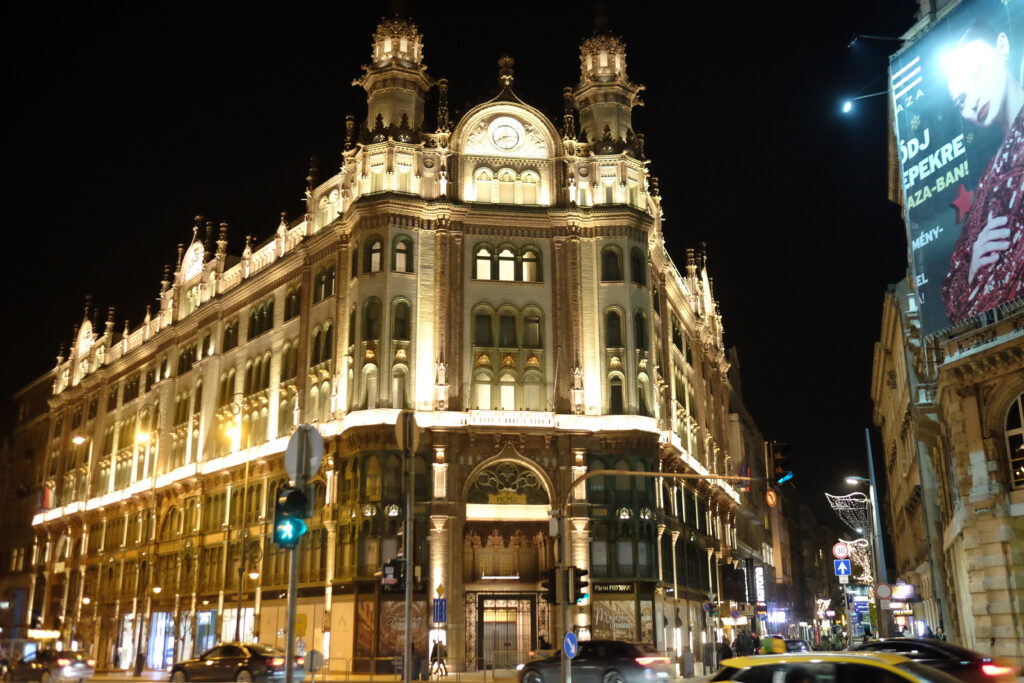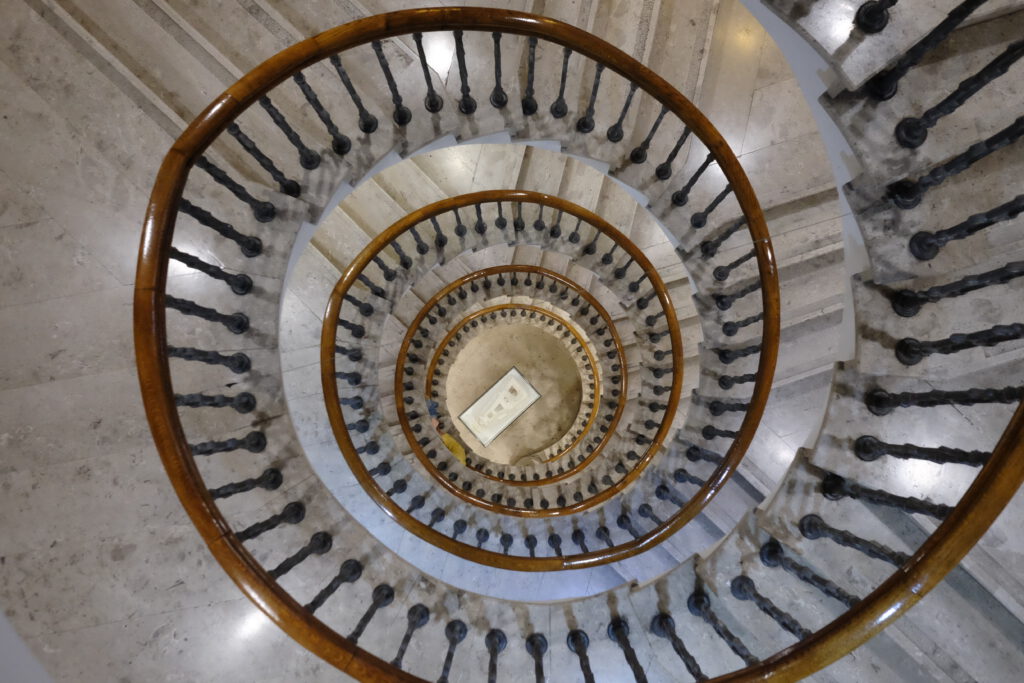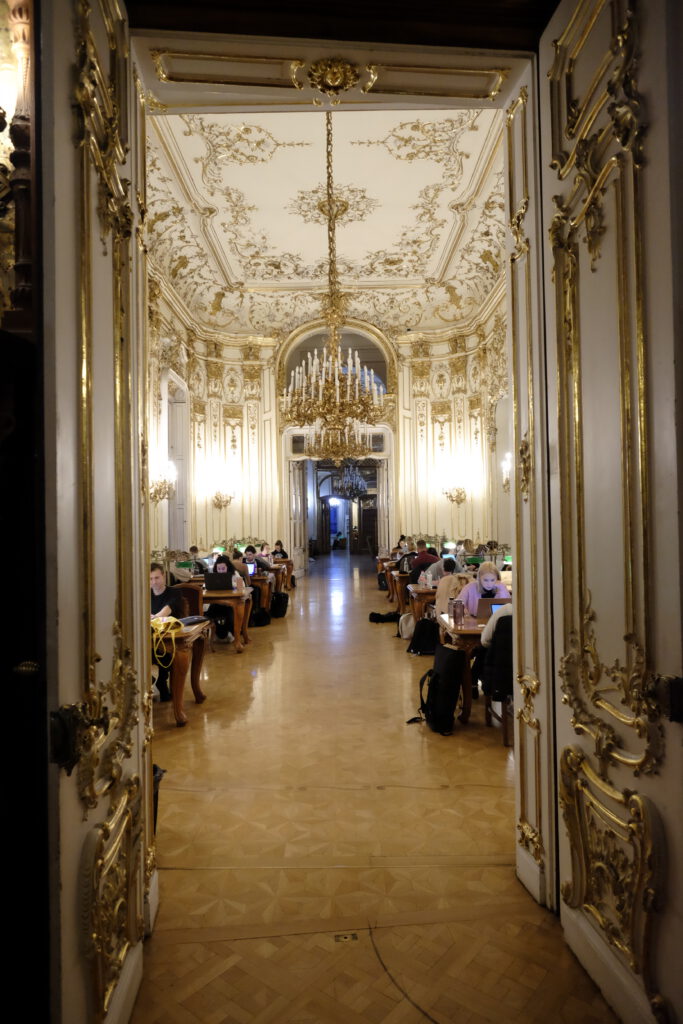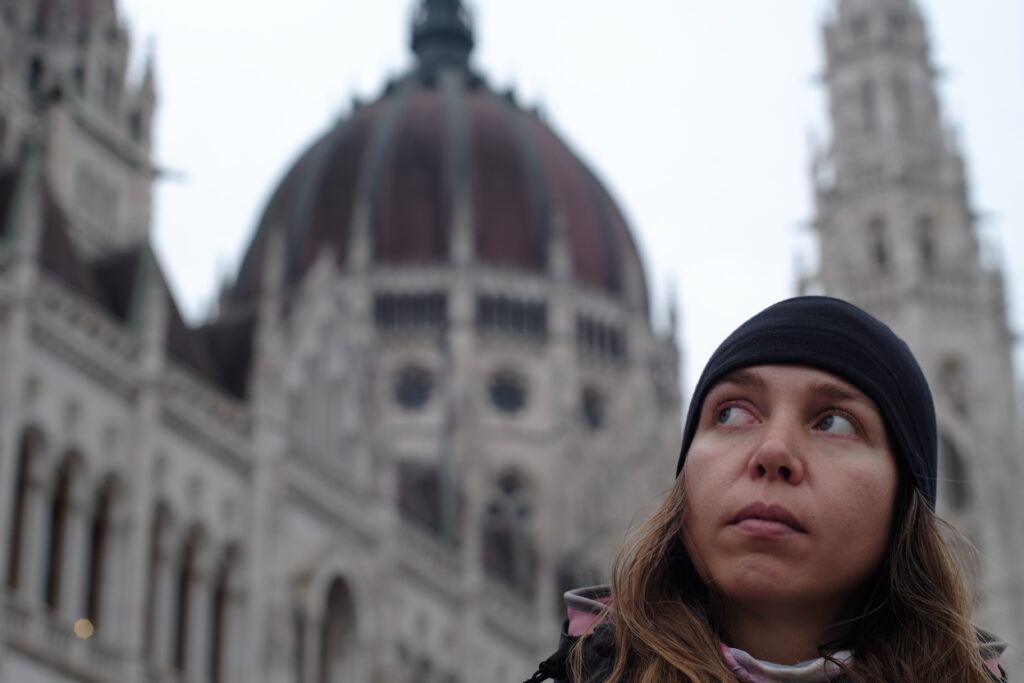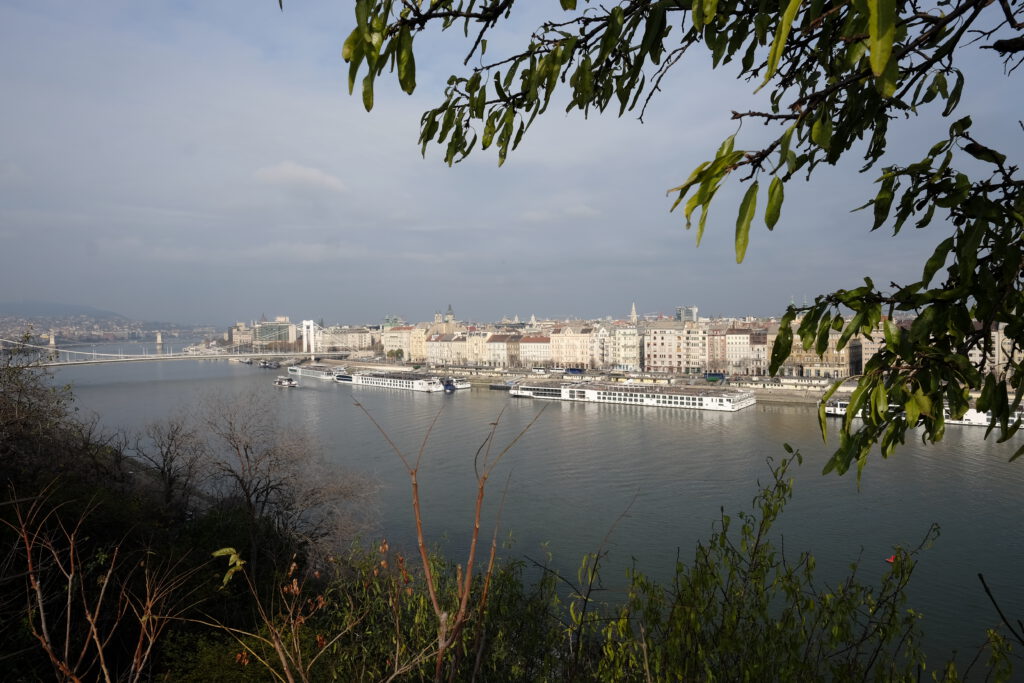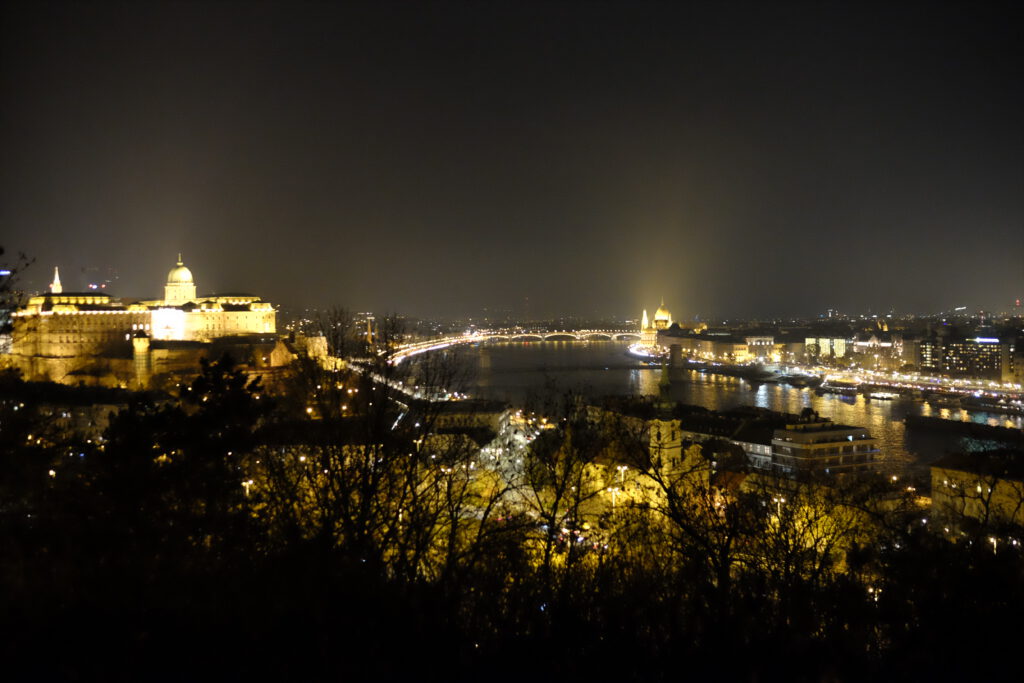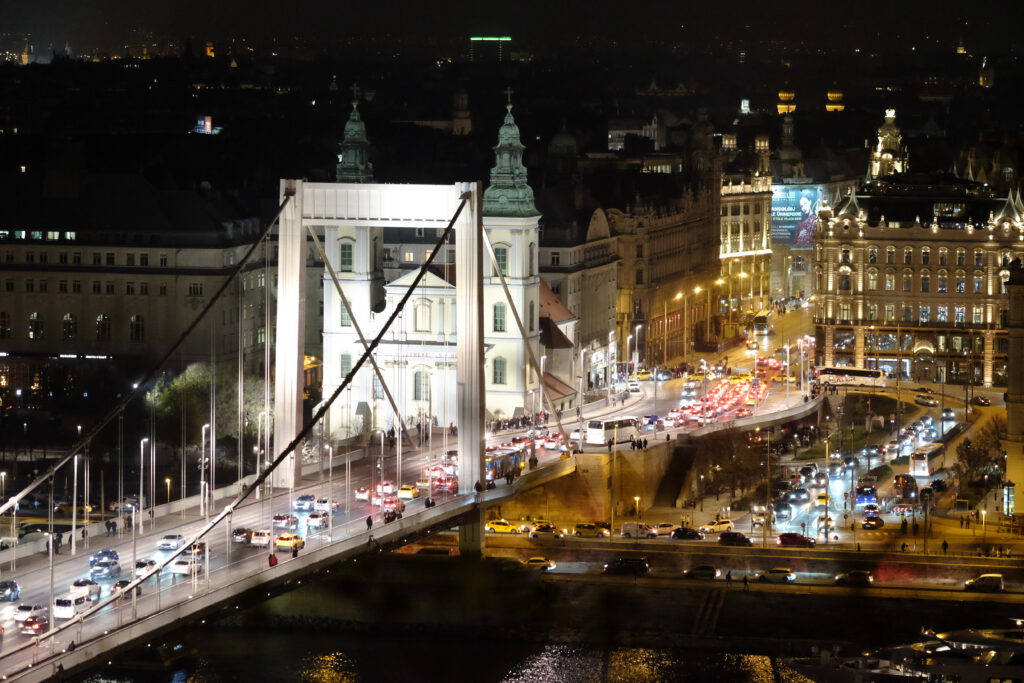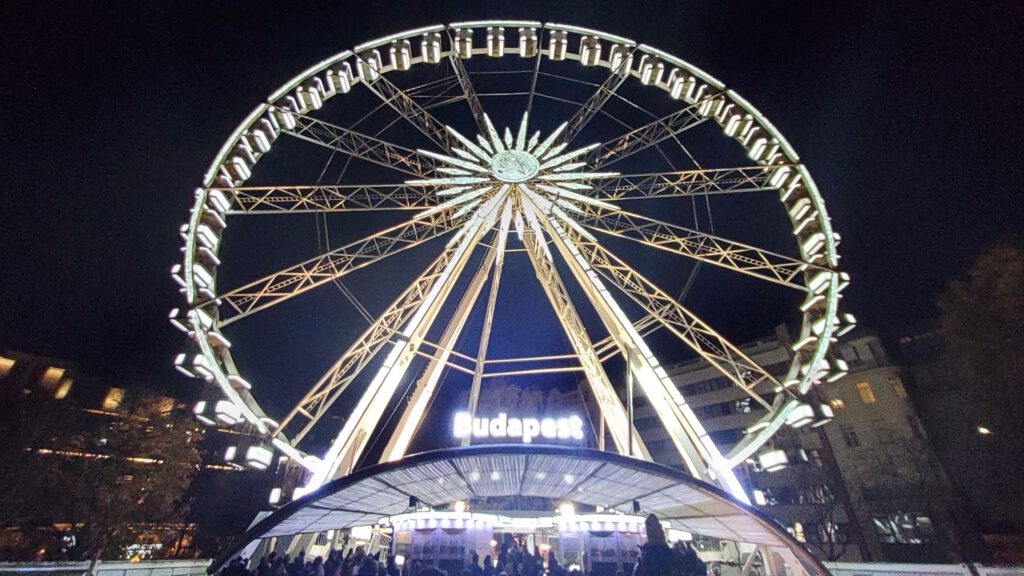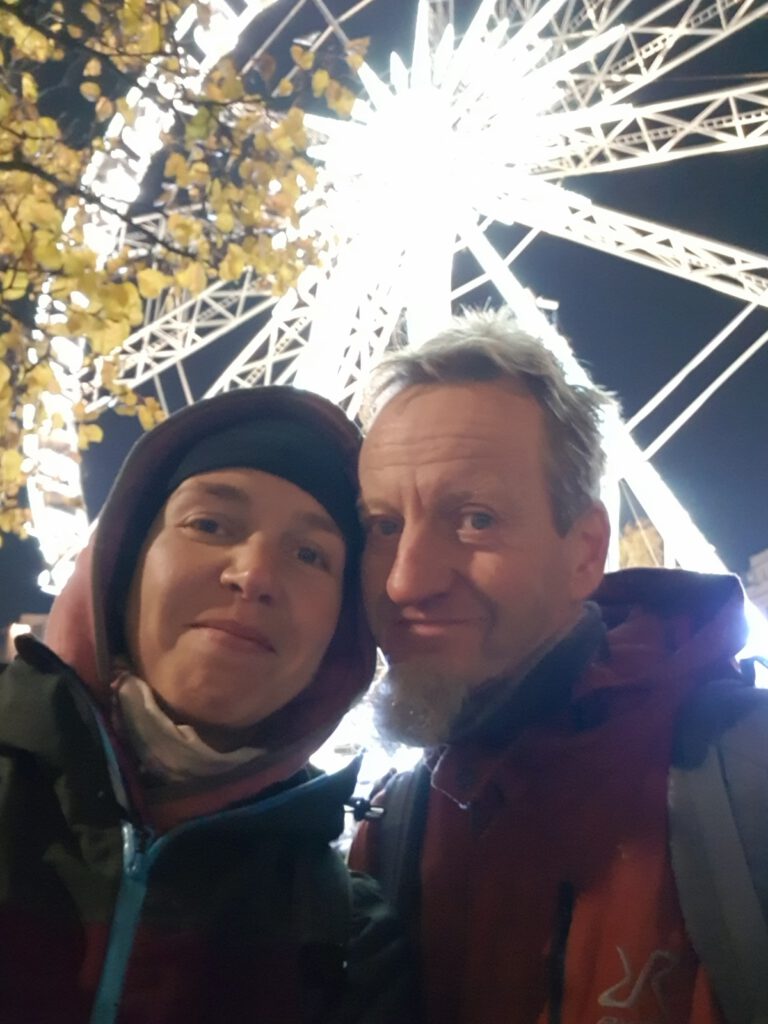Budapest im Dezember

Zum zweiten Mal auf dieser Reise verbringen wir ein paar Tage in dieser beeindruckenden Stadt.
Beim ersten Besuch war es sehr regnerisch, nun ist es sehr kalt. Dafür scheint ab und zu auch mal die Sonne. Wie macht man das bei Temperaturen um die 0 Grad im Bus? Neben der Standheizung ist auch hier ein guter Platz das Entscheidende. Sonne sollte den Bus schon erreichen, sofern sie denn scheint. Wir finden diesen Platz auf dem Gellertberg in einer kleinen Wohnstrasse, die, aus welchem Grund auch immer, nicht zur Parkzone gehört. Wir stehen neben einem großen Garten und haben sogar etwas Aussicht auf die Stadt. Hier werden wir die nächsten drei Nächte verbringen. Zu Fuß können wir einfach von hier die Innenstadt erreichen, zwei Brücken stehen dafür zur Auswahl.
Wasser holen wir einmal zu Fuß von der nahegelegenen Shell Tanke. Das Gute an einer Stadt ist, dass man nicht ab 16 Uhr im Bus sitzen muss, weil man draußen im Dunkeln nichts mehr machen kann. Wir verbringen viel Zeit in Cafes und gehen öfters essen. Dazwischen erkunden wir die Stadt auf langen Spaziergängen und besuchen einige interessante Orte.
Einer dieser Orte ist die Metropolitan Ervin Szabó Library im Wenckheim Palais. In dem geschichtsträchtigen Gebäude ist heute eine moderne Bibliothek der Uni untergebracht, aber einige Räume sind noch im ursprünglichen Stil aufwändig saniert. So eine Bibliothek hatte ich an meiner Uni nicht! Die perfekten Räume für einen Lesesaal. Ich kann vielen Studenten hier förmlich ansehen, wie sie es genießen, hier zu sitzen. Mehr zum Wenckheim Palace in der Infobox.
Interessant ist auch die historische Markthalle, wo es eine Vielzahl von frischen und besonderen Produkten zu kaufen gibt. Wir beschränken uns diesmal auf ein lecjeres Mittagessen im Restaurant Fakanal oben in der Markthalle. Es ist dort nicht gerade sehr günstig, aber alles war frisch und gut. Zwischen vielen Touristen bahnen wir uns den Weg zur Theke, wo man Speisen und Getränke selber auswählen kann,
| Library in the Wenckheim Palace The main building of the Metropolitan Ervin Szabó Library is the one-time Wenckheim Palace. It was buildt by Count Frigyes Wenckheim (1842-1912), a well-known aristocrat of the end of the 19th century, owner of a 170.400 acre estate, a member of the Parliamant. He carried out a number of large-scale charitable actions and was a remarkable builder. Arthur Meining, a specialist of country houses of the aristocracy was entrusted with erecting their palace in Pest. The Wenckheim Palace was an outstanding achievment both of his oevre and of Hungarian Neo-Baroque architecture. The main entrance leads to the Entrance Hall where marble stairs run up to the mezzanine among the four decorated columns supporting the vaulted ceiling. There are chandeliers at the starting of the staircase born by marble putti. The lower flight of the staircase is supported by unusual caryatids, namely dwarfs. The staircase, having a rectangular plan with rounded corners, has a Baroque atmosphere due not only to its Rococo decoration, and the windowless walls ornamented like an arbour, but also to its spaciality and lighting effects: to the strong light flooding through the skylight after the darkness and depressed spatiality of the anterior rooms. The staircase splits into two branches at the landing, then it runs in the opposite direction until its flights unite again on the balcony above the Vestibule on the upper ground-floor. There are three doors opening from this landing. The door in the middle leads to the Saloon, located above the Entrance Hall and the upper level of the projection of the facade, as required by the traditions of palace building, and it is decorated also as usual. There is a Boudoir on both sides: the golden one to the right, the silver one to the left. A small ballroom opens from the latter on the Baross street side, and the Large Ballroom is located behind the small one. The orchestra used to sit on the gallery above the passage between the two ballrooms from where it could play in both directions. The Large Ballroom represents a new scale as compared to the small one both from point of view of its size, and from that of the richness of its decoration. There are no extensive plain surfaces in the stucco frames dividing the wall. The walls as well as the ceiling are all covered with ornamentation becoming more simple only toward the footing. The longer side of the room, facing the windows, is opened by three large arches, and there are huge mirrors behind them in the Corridor broadening the space that served originally as a rest-place for the dancers. In spite of their different characters, the rooms so far have all shared a style resembling the Baroque palaces of the 18th century. However, the layout of the former Dining Room behind the Large Ballroom, and the arrangement of the Smoking Room opening from the Boudoir of the countess at the opposite end of the U-shaped row of rooms are different. Their walls and ceilings are covered with wood, their colours are dark in strong contrast with the white-gold world of the neighbouring rooms. These rooms are also rich in ornamentation, but their decoration is more robust than that of the ballrooms. Two spiral stairs lead to the gallery of the former Smoking Room. The Wenckheim Palace is a masterpiece of Neo-Baroque palace architecture. Its designer used the unfavorable building ground with much creativity and intuition. The exterior of the magnificently decorated palace was following the Baroque tradition of Dresden, while the interior was planned harmoniously in the style of Louis XV. Five hundred people could be entertained in its ballrooms simultaneously, and it was spatial and rich enough for royal visits: the sovereign had also been here. It remained the property of the Wenckheim family for 15 years after the death of its builder. Confusion started in 1919. The palace had been expropriated during the Republic of Councils, first it became the Association of Joiners, then the museum of the Proletariat. As such, it was devastated right after the fall of the Commune. It was taken up for a while by the Rumanian army occupying Budapest, then the club of political parties (later journalists and artists) was housed in the building. In 1926 the idea occurred that the building set up for sale should be purchased for the purposes of the Metropolitan Library. The suitability of the Palace for this purpose had been strongly debated, and the decision was also made among revolting circumstances. However, the city Council purchased the building in 1927. Reconstruction had lasted for four years, and the library was opened in 1931. The state-rooms remained essentially unaltered, while living and service rooms were turned into stacks and offices. |
Wir versuchen zweimal, das Cafe New York zu besuchen, aber jedesmal ist am Eingang eine riesige Schlange und wir geben auf. Alternativen gibt es viele, zum Beispiel das Müvezs Kaffeehaus in der Andrassy str, 29. Für die WLAN Nutzung gehen wir auch gerne ins Mon Cherie am Karoly Körüt 12 (Karlsring). Hier ist eher jüngeres Publikum und wirklich niemand ohne Notebook.
Es gibt natürlich jetzt auch mehrere Weihnachtsmärkte in der Stadt. So langsam verstehen wir auch, daß es bis Weihnachten gar nicht mehr lange dauert. Wir kaufen noch letzte Geschenke für Freunde und probieren die lokalen Spezialitäten.
Am Abend ist das Csendes (Cafe und Bar) in der Ferenczy István u. immer eine gute Adresse, sofern man einen Platz ergattert. Beim Rückweg zum Bus bietet sich abends immer ein toller Blick über die Donau mit der hell erleuchteten Stadt.
Passend zum Startfoto der Tour im ersten Artikel gibt es natürlich wieder ein Selfie am Riesenrad, da Budapest unsere letzte richtige Station der Reise ist. Von Budapest aus geht es nun langsam Richtung Westen und nach Hause. Unsere Reise über Landstraßen führt uns über Györ nach Österreich. In der Nähe von Wien und nochmal kurz vor Passau gibt es jeweils eine Übernachtung. Die Donau wird wieder mal unser ständiger Begleiter. Unsere Freunde Manja und Ingo sind mittlerweile umgezogen und haben Nachwuchs bekommen. Natürlich bleiben wir dort noch eine Nacht bei Ingolstadt, bevor es endgültig zurück nach Ludwigsburg geht.
Der nächste Artikel wird noch ein paar Zahlen und Fakten zur Reise enthalten.


